by Christopher S. | Jan 16, 2025 | App Store Optimization |
Introduction
App Store Optimization (ASO) is the process of improving your app’s visibility and conversion rates within app stores. It’s a critical component of any app marketing strategy, helping your app reach its target audience and drive downloads.
What is App Store Optimization?
ASO involves optimizing various elements of your app store listing to increase its discoverability. These include the app title, description, keywords, visuals, and reviews. By improving these factors, your app ranks higher in search results, making it more likely to be downloaded.
- Optimizes app store listing elements.
- Increases visibility and search rankings.
- Drives organic downloads and engagement.
Why is ASO Important?
With millions of apps available in app stores, ASO ensures your app stands out from the competition. A strong ASO strategy directly impacts your app’s success by:
- Improving visibility in crowded marketplaces.
- Attracting high-quality users actively searching for solutions your app offers.
- Reducing user acquisition costs by driving organic traffic.
Why Now is the Best Time for ASO
The mobile app market is more competitive than ever, with over 5 million apps across Google Play and the Apple App Store. As user acquisition costs rise, ASO offers a cost-effective way to attract users and increase downloads. Additionally, search algorithms within app stores are constantly evolving, making it essential to keep your ASO strategy updated.
- Rising competition requires a strong ASO strategy.
- User acquisition costs are increasing, making organic traffic vital.
- Algorithms evolve, necessitating continuous optimization.
Top 10 Points to Consider for ASO
- Keyword Research: Identify relevant keywords that align with your app’s core features and target audience.
- Optimize App Title: Use primary keywords in the title to improve discoverability.
- Craft a Compelling Description: Highlight key features and benefits, incorporating secondary keywords naturally.
- Use High-Quality Screenshots: Showcase your app’s interface and features to attract users.
- Create an Engaging Video Preview: Demonstrate your app’s value through a short, visually appealing video.
- Encourage Positive Reviews and Ratings: Social proof significantly impacts download decisions and rankings.
- Focus on App Icon Design: A visually appealing icon can increase clicks and downloads
- Localize for Different Markets: Translate your app listing for global audiences to expand reach.
- Monitor and Analyze Performance: Use analytics tools to track downloads, impressions, and conversions.
- Regular Updates: Keep your app updated with new features and bug fixes to maintain user interest.
- Keyword research and optimized titles are essential.
- High-quality visuals and localization enhance appeal.
- Regular updates and monitoring ensure sustained success.
Top 5 Don’ts of ASO
- Don’t Overstuff Keywords: Avoid cramming too many keywords into your title or description, as it can harm readability and rankings.
- Don’t Neglect Visuals: Poor-quality screenshots or icons can deter potential users.
- Don’t Ignore User Reviews: Failing to respond to feedback can harm your app’s reputation.
- Don’t Use Misleading Descriptions: Ensure your app delivers what your listing promises to avoid negative reviews.
- Don’t Forget to Test: Continuously A/B test different elements of your listing to identify what works best.
- Avoid keyword stuffing and poor visuals.
- Address user reviews promptly.
- Always test and refine your ASO strategy.
Closing Note
App Store Optimization is a crucial strategy for ensuring your app stands out in a competitive marketplace. By focusing on the right elements and avoiding common mistakes, you can increase your app’s visibility, drive downloads, and improve user satisfaction. Partner with our agency to develop a winning ASO strategy and elevate your app’s success. Contact us today!
by Christopher S. | Nov 7, 2024 | App Store Optimization, Blogs |
Introduction About Top ASO Tools
With the sheer volume of apps available in 2024, standing out in the app stores has never been more challenging. This is where App Store Optimization (ASO) comes into play. ASO is like SEO for apps, aiming to improve app visibility, attract more downloads, and ultimately secure app success in a crowded market. Let’s dive into the top ASO tools that can help you make a powerful impact in the app store.
What is ASO and Why is it Crucial?
ASO encompasses strategies and techniques to improve app ranking in search results within app stores. A good ASO strategy focuses on optimizing keywords, app descriptions, visuals, and user feedback to boost visibility and download rates.
Factors Influencing ASO
Several factors drive ASO success, and understanding them helps in selecting the right ASO tools:
- Keywords and Metadata: Proper keyword usage in titles and descriptions ensures your app appears in relevant searches.
- User Reviews and Ratings: High ratings improve visibility and encourage downloads.
- Visuals and User Experience: Screenshots, videos, and app icons significantly impact conversion rates.
Top ASO Tools to Use in 2024
To achieve the best results, here’s a curated list of the top ASO tools designed to meet various ASO needs.
#1: AppTweak
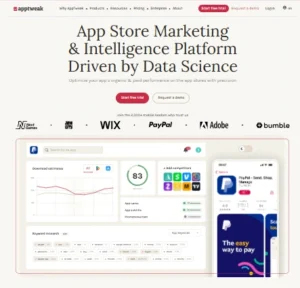
Key Features: AppTweak provides data-driven insights on keywords, ad intelligence, and ASO performance across app stores.
Pros: Known for its robust keyword research features and user-friendly interface.
Cons: Pricing might be a bit high for smaller developers.
Website URL: www.apptweak.com
#2: Sensor Tower

Key Features: Sensor Tower specializes in competitive analysis, giving insights into how your app stacks up against competitors.
Pros: Exceptional for tracking competitor performance and identifying emerging trends.
Cons: Not as focused on keyword discovery for beginners.
Website URL: www.sensortower.com
#3: AppFollow
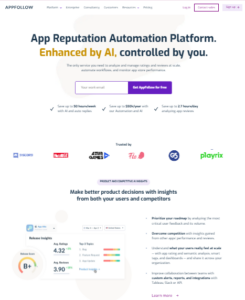
Key Features: AppFollow emphasizes tracking user feedback, helping you respond to reviews and ratings efficiently.
Pros: Great for maintaining a positive user rating, which can boost visibility.
Cons: Limited in keyword optimization tools compared to others.
Website URL: www.appdollow.io
#4: Mobile Action
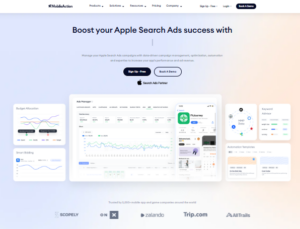
Key Features: Known for its unique advertising insights, Mobile Action is excellent for those looking to integrate ASO with paid marketing.
Pros: Combines ASO with ad insights, making it ideal for a holistic approach.
Cons: Some features are limited in the free version.
Website URL: www.mobileaction.co
#5: TheTool
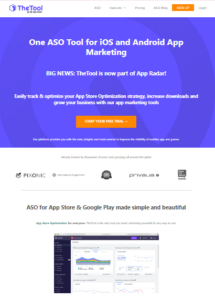
Key Features: TheTool’s intuitive dashboard allows you to monitor all ASO metrics in one place.
Pros: Perfect for beginners due to its ease of use and visual representation of ASO metrics.
Cons: Lacks advanced features required by more experienced ASO professionals.
Website URL: www.thetool.io
#6: ASOdesk

Key Features: ASOdesk stands out for its ability to generate keyword suggestions tailored to your app’s niche.
Pros: Ideal for keyword discovery, especially for niche apps.
Cons: Limited in tracking visual assets compared to other tools.
Website URL: www.asodesk.com
#7: Keyword Tool
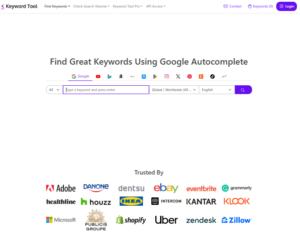
Key Features: Keyword Tool focuses on keyword discovery and tracking, which is central to improving app search rankings.
Pros: Excellent for those focused primarily on keyword optimization.
Cons: Limited in competitive insights.
Website URL: www.keywordtool.io
Comparing Paid vs. Free ASO Tools
Free ASO tools can be great for startups with limited budgets, but paid tools often provide additional features, such as competitor analysis and ad insights. For scaling businesses, investing in a paid tool can deliver valuable, in-depth data that free tools may not offer.
How to Choose the Top ASO Tool for Your Needs
When selecting an ASO tool, consider your budget, primary goals (keywords, reviews, or competitive analysis), and the app’s current market position. For instance, a new app may prioritize tools focused on keywords, while a seasoned app may focus more on competitive analysis.
Best Practices for Using ASO Tools
- Regularly Update Keywords: App trends shift often; updating keywords monthly can help maintain relevance.
- Engage with User Feedback: Responding to reviews, especially negative ones, can improve ratings.
- Track Competitors: Monitoring competitor strategies can reveal gaps or new opportunities for optimization.
Conclusion
In today’s competitive app market, having the Top ASO tools can make all the difference between getting noticed and getting lost. By leveraging top tools like AppTweak, Sensor Tower, and Mobile Action, app developers can optimize keywords, monitor competitors, and engage users effectively, driving more downloads and engagement.
To further enhance your app’s reach and success, consider partnering with App Marketing Plus. As a dedicated app marketing agency, App Marketing Plus specializes in boosting app visibility, user acquisition, and downloads through advanced ASO strategies tailored to your app’s unique needs. From keyword optimization to conversion-focused advertising, we provide everything you need to stand out in the app store. Ready to make your app shine? Visit App Marketing Plus today and start maximizing your app’s potential!
FAQs
1. What is the Top ASO tool for beginners?
For beginners, tools like The Tool and AppTweak are great due to their user-friendly interfaces and essential ASO features.
2. How often should I update my ASO strategy?
Ideally, update your ASO strategy every 30-60 days to align with trends and maintain keyword relevance.
3. Can Top ASO tools replace an ASO specialist?
No, while ASO tools are powerful, they complement rather than replace the expertise and strategy of a specialist.
4. What’s the average cost of Top ASO tools?
Prices vary widely, from free to several hundred dollars per month depending on the features and capabilities.
5. Do ASO tools work for both iOS and Android?
Yes, most ASO tools offer support for both iOS and Android platforms, but it’s wise to confirm compatibility.
by Christopher S. | Oct 17, 2024 | App Store Optimization |
What is ASO (App Store Optimization)
App Store Optimization (ASO) has quickly become an essential strategy for any app developer or marketer aiming to boost their app’s visibility in the crowded app store marketplace. In this comprehensive guide, we will take you through everything you need to know about ASO—from its definition to a step-by-step breakdown of how to rank better in the app stores. Whether you’re new to the term or looking to fine-tune your current strategy, this guide will equip you with actionable insights to enhance your app’s rankings. here is the answer for what is ASO ( App Store Optimization )
Introduction to ASO
Defining App Store Optimization (ASO)
App Store Optimization, commonly referred to as ASO, is the process of improving the visibility and discoverability of an app within an app store, such as the Apple App Store or Google Play Store. Think of ASO as the SEO of the app world, designed specifically to drive traffic and conversions in app store environments. While SEO targets search engines like Google, ASO is tailored to the algorithms used by app stores to rank and recommend apps.
What Is ASO and Why is Important for App Visibility
The importance of ASO cannot be overstated. With millions of apps competing for attention, effective ASO can mean the difference between an app that thrives and one that gets lost in the shuffle. ASO helps you improve your app’s organic rankings, leading to higher visibility in search results, more downloads, and ultimately, increased revenue.
How ASO Works: Key Components
There are two main components of ASO: on-metadata and off-metadata factors. Understanding the balance between these factors is key to optimizing your app for maximum visibility.
On-Metadata Factors
On-metadata factors refer to the elements you have direct control over, such as the app’s title, description, and keywords. These factors are crucial in informing both the app store and potential users about your app’s purpose and value.
Off-Metadata Factors
Off-metadata factors are those influenced by external factors, such as user reviews, ratings, and the overall user experience. While you cannot directly control these elements, optimizing your app to encourage positive user feedback can significantly impact your ASO efforts.
On-Metadata ASO Factors
Choosing the Right App Title
Your app’s title is arguably the most important on-metadata factor. It not only represents your brand but also directly influences how your app ranks in search results. A well-optimized title should include your main keywords without sounding forced.
Importance of Keyword Optimization
Keyword optimization is the backbone of any successful ASO strategy. Just as with SEO, the strategic placement of relevant keywords in your app’s title, subtitle, and description can significantly improve your ranking. Conduct thorough keyword research to understand what terms potential users are searching for.
App Descriptions that Convert
A well-written app description does more than explain your app’s features—it also persuades users to download. Focus on highlighting the app’s unique selling points, and use bullet points to make the description easy to scan.
Crafting Effective App Icons
Your app icon is the first thing users see, making it a critical element in your ASO strategy. An eye-catching, professional-looking icon can help differentiate your app from competitors, driving more clicks and downloads.
Off-Metadata ASO Factors
User Ratings and Reviews
User ratings and reviews are one of the most influential off-metadata factors. Apps with higher ratings and more positive reviews are favored by app store algorithms, leading to better visibility.
App Download and Retention Rates
The number of downloads your app receives and its retention rate also play a significant role in ASO. App stores tend to favor apps that not only get downloaded frequently but also retain users over time.
The Role of Visuals in ASO
Impact of Screenshots and Preview Videos
Incorporating high-quality screenshots and preview videos is another way to boost your app’s appeal. These visuals provide users with a sneak peek into what they can expect from your app, encouraging more downloads.
The Impact of ASO on Organic Downloads
How ASO Affects App Discovery
One of the primary goals of ASO is to increase your app’s visibility in organic search results, which can lead to more organic downloads. By improving your app’s metadata and encouraging positive reviews, you can help your app rank higher and attract more users organically.
ASO vs. SEO: Understanding the Difference
Similarities and Differences Between ASO and SEO
While ASO and SEO share many similarities—such as the use of keywords to rank higher in search results—they differ in their platforms and algorithms. ASO is focused on optimizing apps within app stores, while SEO is geared toward improving websites on search engines.
Tools for ASO Success
Best ASO Tools to Use
There are several tools available to help you optimize your app, including App Annie, Sensor Tower, and TheTool. These tools can assist with keyword research, competitor analysis, and performance tracking to ensure your ASO strategy is on point.
Common ASO Mistakes and How to Avoid Them
Pitfalls in Keyword Targeting
One common mistake in ASO is using overly competitive keywords. Instead, focus on long-tail keywords that are relevant to your app but have less competition.
Misleading Visuals or Descriptions
Another pitfall is using misleading visuals or descriptions to entice users to download your app. This can lead to poor user reviews and high uninstall rates, both of which negatively impact your ASO efforts.
Measuring the Success of ASO Efforts
Tracking ASO Metrics: What to Monitor
To gauge the success of your ASO strategy, it’s important to track metrics such as your app’s search rankings, download numbers, and user engagement. Regularly reviewing these metrics will allow you to make data-driven decisions and continuously improve your ASO efforts.
FAQs
1. How long does ASO take to show results?
Typically, ASO results can take anywhere from a few weeks to several months, depending on factors such as competition and the frequency of app store algorithm updates.
2. Is ASO necessary for all apps?
Yes, ASO is crucial for all apps, regardless of their category. Optimizing for app store visibility ensures that potential users can easily discover your app.
3. Can ASO be automated?
While some aspects of ASO can be automated, such as keyword research using ASO tools, it’s important to manually fine-tune your strategy for best results.
4. What is ASO and SEO Difference?
ASO is specifically focused on optimizing apps within app stores, while SEO is designed for improving visibility on web search engines like Google.
5. How often should ASO be updated?
Your ASO strategy should be updated regularly to keep up with changes in app store algorithms and user behavior. Regular updates can help maintain or improve your app’s ranking.
6. How does ASO influence organic downloads?
By optimizing your app’s metadata and improving user engagement, ASO can significantly increase the number of organic downloads your app receives.
Conclusion ( What is ASO )
Here is all about What is ASO (App Store Optimization). ASO plays a pivotal role in ensuring your mobile app gains visibility and ranks higher in app store search results. However, mastering ASO requires the right strategy, consistent updates, and expert insights. For businesses seeking to maximize their app downloads and boost user engagement, App Marketing Plus offers tailored app marketing solutions designed to enhance your app’s performance across platforms. Whether you need help with ASO, app promotion, or download campaigns, App Marketing Plus has the expertise to take your app to the next level.
Additionally, having a well-optimized website is essential for driving traffic and ensuring that users can easily find your app or services online. Gegosoft SEO Services is your go-to solution for improving website visibility through expert SEO strategies. By leveraging cutting-edge SEO practices, Gegosoft helps businesses climb search engine rankings, generate more leads, and engage with their target audience effectively. Together, App Marketing Plus and Gegosoft SEO Services provide a comprehensive digital marketing package that ensures both your app and website reach their full potential.
Boost your app downloads and improve your online presence today with App Marketing Plus and Gegosoft SEO Services!
Contact Us For More Details!
by Christopher S. | Oct 1, 2024 | App Store Optimization |
App Store Optimization (ASO) is an essential aspect of mobile app success. With millions of apps in both the Apple App Store and Google Play Store, standing out in the crowd can be tough. That’s where ASO tools come into play, helping you optimize your app’s visibility, increase downloads, and improve user retention. Whether you’re a developer or a marketer, having the right ASO tools at your disposal can make all the difference. In this article, we’ve compiled the ultimate App Store Optimization Tools for iOS and Android, covering keyword optimization, analytics, A/B testing, and more.
1. App Annie
App Annie is one of the most popular App Store Optimization Tools for iOS and Android. It offers comprehensive data and insights on app rankings, downloads, and user engagement. With keyword tracking and competitive analysis, you can monitor your app’s performance across both iOS and Android platforms.
Key Features:
- Competitor tracking and benchmarking
- Download and revenue estimates
- Market data and keyword tracking
2. Sensor Tower
Sensor Tower helps you understand the app store ecosystem by providing in-depth analytics. Its keyword research feature allows you to find relevant keywords, analyze competitors, and track your app’s ranking over time.
Key Features:
- Keyword optimization and tracking
- Competitor analysis
- Performance monitoring for both iOS and Android
3. Mobile Action
Mobile Action is an all-in-one App Store Optimization Tools for iOS and Android that provides keyword research, rank tracking, and A/B testing. It’s designed for app marketers looking for an easy-to-use platform with actionable insights.
Key Features:
- Keyword suggestions and tracking
- Competitive insights
- Custom reports and A/B testing capabilities
4. TheTool
As its name suggests, TheTool is a specialized App Store Optimization Tools for iOS and Android focusing on app store performance. It offers essential metrics such as organic installs, rankings, and ratings, enabling you to understand what drives growth for your app.
Key Features:
- ASO score and suggestions for improvement
- Download tracking and user engagement analytics
- Custom dashboards for performance monitoring
5. App Radar
App Radar offers a suite of ASO tools for both Android and iOS apps. From keyword optimization to A/B testing, it allows you to make data-driven decisions. The user-friendly interface makes it ideal for both beginners and experienced app marketers.
Key Features:
- Easy-to-use keyword explorer
- Competitor analysis and tracking
- Localization support for multiple languages
6. Apptweak
Apptweak is an ASO platform offering advanced keyword research, competitor analysis, and performance monitoring. It’s trusted by leading app developers and marketers for improving app visibility and downloads.
Key Features:
- Comprehensive keyword research tool
- Competitor insights
- Keyword rankings and traffic estimations
7. ASOdesk
ASOdesk provides detailed insights into how users find apps, including keyword ranking and search volume. It’s a great tool for optimizing your app’s metadata, including titles, descriptions, and keywords.
Key Features:
- Keyword research and tracking
- Search volume estimation
- Review and ratings analysis
8. Gummicube
Gummicube focuses on real-time data from app stores to help optimize app visibility. With a strong emphasis on data accuracy, Gummicube is perfect for developers who want to focus on organic growth.
Key Features:
- Real-time app store data
- A/B testing for metadata
- Competitor tracking and keyword suggestions
9. SplitMetrics
SplitMetrics is an A/B testing platform for app store creatives, including app icons, screenshots, and videos. By running experiments, you can see which visuals and app details resonate best with your target audience.
Key Features:
- A/B testing for app icons, screenshots, and descriptions
- In-depth analytics on user behavior
- Performance tracking for app listings
10. Storemaven
Storemaven is another A/B testing tool that allows you to test different versions of your app store page to determine which elements work best in driving downloads. Its in-depth reporting helps fine-tune your app store strategy.
Key Features:
- Customizable A/B testing
- Engagement metrics tracking
- Conversion rate optimization
Conclusion
App Store Optimization is crucial for getting your app discovered in a crowded marketplace. By using the right App Store Optimization Tools for iOS and Android—such as App Annie, Sensor Tower, and Mobile Action—you can gain valuable insights into your app’s performance, track competitors, and optimize keywords for increased visibility and downloads. These tools will help you navigate the challenges of the app store landscape and achieve long-term success.
If you’re serious about growing your app’s visibility and increasing downloads, it’s time to invest in a solid app marketing strategy. Along with ASO, utilizing a comprehensive app marketing approach, including paid ads, social media promotion, and user acquisition strategies, can elevate your app to the next level.
At App Marketing Plus, we specialize in app marketing, helping you reach your target audience through a mix of ASO and effective marketing campaigns. Whether you’re launching a new app or looking to grow an existing one, our team of experts is here to guide you every step of the way. Ready to take your app to the top? Contact us today and let’s start optimizing!
by Christopher S. | Sep 25, 2024 | App Store Optimization, Blogs |
App Store Optimization Company
In the ever-evolving landscape of mobile applications, standing out in the crowded app stores can feel like searching for a needle in a haystack. With millions of apps vying for users’ attention, how can yours get the spotlight it deserves? Enter the realm of App Store Optimization (ASO). Collaborating with the right App Store Optimization Company can be the game-changer that propels your app’s downloads and boosts its visibility. In this post, we’ll explore how a professional ASO service can help unlock your app’s full potential and skyrocket your downloads.
Understanding App Store Optimization (ASO)
What is ASO?
ASO is the process of optimizing mobile apps to rank higher in an app store’s search results. This involves various strategies to enhance your app’s visibility, conversion rate, and ultimately its downloads. Just like SEO for websites, ASO focuses on keywords, app titles, descriptions, and visuals.
Why is ASO Important?
With over 4 million apps available on the Apple App Store and Google Play Store, effective ASO can dramatically influence your app’s success. It’s essential for:
- Increased Visibility: Higher rankings mean more potential users see your app.
- Higher Conversion Rates: Optimized descriptions and visuals can convert viewers into downloaders.
- Cost-Effectiveness: A well-optimized app can reduce the need for extensive paid marketing.
Key Benefits of Partnering with an AppMarketingPlus
Expert Knowledge and Experience
Choosing an experienced ASO company means gaining access to a wealth of knowledge. They understand the intricacies of app store algorithms and have proven strategies to enhance your app’s performance.
Tailored Strategies
No two apps are alike. A professional ASO service tailors strategies specifically for your app’s niche, audience, and competition. They perform in-depth market research to ensure your app meets user expectations.
Ongoing Optimization
The app store environment is dynamic, requiring continual adjustments. A reliable ASO company provides ongoing analysis and updates, ensuring your app adapts to changes in algorithms and user behavior.
Essential ASO Techniques
Keyword Research
Just as keywords are vital for SEO, they are equally important for ASO. The right ASO company conducts comprehensive keyword research to identify the terms potential users are searching for. This research involves:
- Analyzing Competitors: Understanding which keywords competitors rank for.
- Identifying Long-Tail Keywords: These often have lower competition and can drive targeted traffic.
Compelling App Title and Description
Your app’s title and description are crucial for both visibility and conversion. An ASO expert can help craft:
- An Engaging Title: It should include primary keywords while being catchy and memorable.
- A Persuasive Description: Highlight key features, benefits, and a clear call-to-action to entice users.
Visual Elements: Icons and Screenshots
Visuals are the first impression users have of your app. An ASO company knows how to design:
- Attractive Icons: A unique icon can catch the user’s eye and encourage downloads.
- Informative Screenshots: High-quality screenshots showcasing app functionality can help convey value effectively.
Choosing the Right App Store Optimization Company
Look for Proven Success
When searching for an ASO company, consider their track record. Look for case studies or testimonials from previous clients to gauge their effectiveness.
Services Offered
Ensure the ASO company provides comprehensive services, including:
- Keyword research
- App design consultation
- Performance analytics
Transparent Communication
Choose a company that values communication and keeps you informed about progress and strategies. A collaborative approach leads to better outcomes.
Real-Life Success Stories
Case Study: An E-commerce App
An e-commerce app struggling with visibility partnered with an App Store Optimization Company that revamped its keyword strategy. After implementing targeted keywords and enhancing its visuals, the app saw a 300% increase in downloads within three months!
Case Study: A Gaming App
A gaming app optimized its app store presence through professional ASO, focusing on compelling visuals and descriptions. This resulted in a 50% increase in user engagement and a significant rise in downloads.
Conclusion-App Store Optimization Company
In a world where app downloads can make or break your business, leveraging the expertise of an AppmarketingPlus can be the key to unlocking your app’s success. By implementing tailored strategies, optimizing keywords, and enhancing visuals, the right partner can propel your app to new heights. If you’re ready to boost your app’s visibility and downloads, consider investing in professional App Store Optimization Company.
FAQs
1. What is the average cost of ASO services?
Costs vary based on the company and services offered, typically ranging from a few hundred to several thousand dollars per month.
2. How long does it take to see results from ASO?
While some improvements can be seen in weeks, significant changes in downloads often take 3-6 months of consistent optimization.
3. Can I handle ASO on my own?
Yes, but partnering with experts can provide insights and strategies that may be challenging to implement independently.
4. What are some common mistakes in ASO?
Common mistakes include neglecting keyword research, poor visuals, and not updating the app store listing regularly.
5. How often should I update my app store listing?
Regular updates, at least every few months, are essential to adapt to changing trends and user preferences.
by Christopher S. | Sep 20, 2024 | App Store Optimization, Blogs |
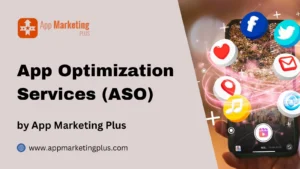
App Optimization Services
In today’s competitive digital landscape, app optimization is crucial for success. Businesses invest in app development, but without proper optimization, your app could remain invisible in app stores. To make sure your app stands out, it’s essential to implement effective app marketing strategies. Let’s dive into the key aspects of app optimization services by app marketing plus and how they can drive success.
What is App Store Optimization (ASO)?
App Store Optimization (ASO) is the process of improving the visibility of a mobile app in app stores such as Google Play and Apple’s App Store. It involves optimizing various elements like app title, description, and keywords to ensure that your app ranks higher in search results. Higher rankings lead to more downloads, ultimately boosting your app’s success.
Why ASO Matters for Your App
ASO is essential because it directly impacts the discoverability of your app. With millions of apps available, users often rely on search results within app stores to find the right solution. A well-optimized app has a higher chance of appearing at the top, increasing the chances of being downloaded. It’s a long-term strategy to maintain steady traffic and user engagement.
Key Factors to Boost Your App Ranking
1. Relevant Keywords
Identifying and integrating relevant keywords into your app’s title and description is vital for ASO success. These keywords help the app store algorithms understand what your app is about and match it with user queries. Conduct thorough keyword research to ensure that you’re targeting terms that your audience is searching for.
2. Compelling App Title and Description
Your app’s title should be concise yet informative. It must include the main keyword for better visibility. Similarly, the description needs to be engaging, highlighting the app’s key features, functionalities, and benefits. A clear call-to-action in the description can also drive users to download the app.
3. High-Quality Screenshots and Videos
Visual elements play a significant role in convincing potential users to download your app. Make sure you include high-quality screenshots that display the app’s features and interface. A short, informative video can also boost your app’s credibility, showing users exactly how the app works.
4. Positive Reviews and Ratings
Positive reviews and high ratings are indicators of an app’s quality. Encourage satisfied users to leave reviews and ratings. App store algorithms take these into account, and apps with better ratings tend to rank higher. Responding to reviews, both positive and negative, can also show that you care about user experience.
5. Regular Updates
Keeping your app up-to-date is essential for maintaining user satisfaction and improving your ranking. Regular updates with bug fixes, new features, or design improvements show that your app is active and evolving. It also keeps users engaged and returning for the latest features.
App Marketing: Expanding Beyond ASO
While ASO is critical for initial discoverability, app marketing expands your reach beyond app stores. Promoting your app through various digital marketing channels ensures that you engage with a broader audience. Here are a few app marketing strategies to consider:
1. Social Media Promotion for App Optimization Services
Social media platforms like Facebook, Instagram, and Twitter offer excellent opportunities to promote your app. Create engaging posts, share user testimonials, and run targeted ads to attract new users. Social media is also a great place to gather feedback and interact with your audience.
2. Influencer Partnerships
Collaborating with influencers who align with your app’s target audience can significantly boost your app’s visibility. Influencers can showcase your app to their followers, providing credibility and encouraging downloads.
3. Paid Advertising Campaigns
Paid campaigns such as Google Ads and Facebook Ads can drive immediate traffic to your app. With precise targeting, you can ensure that your ads are shown to users most likely to be interested in your app. Monitor these campaigns closely to optimize performance and ROI.
The Role of Data and Analytics in App Optimization Services
Tracking and analyzing user data is crucial to the success of your app. It helps you understand user behavior, preferences, and areas for improvement. Tools like Google Analytics or in-app analytics platforms can provide insights into how users interact with your app, allowing you to make informed decisions on updates and marketing efforts.
1. User Engagement Metrics
Metrics such as daily active users (DAU), session length, and user retention rate provide valuable information about how engaged your users are. Higher engagement often leads to better app store rankings, as it signals to the algorithm that users find your app valuable.
2. Conversion Rate Optimization
Optimizing the conversion rate is essential for turning app visitors into loyal users. From the app store listing to in-app features, each step should be optimized to provide the best possible user experience and encourage downloads.
Conclusion: Elevate Your App’s Success with App Optimization Services
App optimization services are the backbone of a successful app marketing strategy. By focusing on ASO, leveraging marketing strategies, and analyzing user data, you can significantly increase your app’s visibility, downloads, and long-term success. Whether you’re launching a new app or looking to improve an existing one, these techniques are essential to driving growth in today’s competitive app landscape.
FAQs
1. What is App Store Optimization (ASO)?
App Store Optimization (ASO) is the process of enhancing your app’s visibility in app stores like Google Play and Apple’s App Store. It involves optimizing the title, description, keywords, and other elements to rank higher in app search results, leading to more downloads.
2. Why is App Optimization Services important for my app?
App Optimization Services is essential because it improves your app’s visibility in app store search results. This increased visibility directly impacts the number of downloads, which helps boost app performance and success.
3. How do keywords affect app optimization?
Keywords are crucial in ASO because they help app store algorithms understand your app’s purpose and content. By including relevant keywords in your app title and description, you can rank higher for search queries related to your app.
4. How can I improve my app’s ranking in app stores?
To improve your app’s ranking, you should focus on ASO factors such as relevant keywords, a compelling title, high-quality screenshots, positive reviews, and regular app updates.
5. What are some key app marketing strategies beyond ASO?
In addition to ASO, you can promote your app through social media, influencer partnerships, and paid advertising campaigns on platforms like Google Ads and Facebook.








